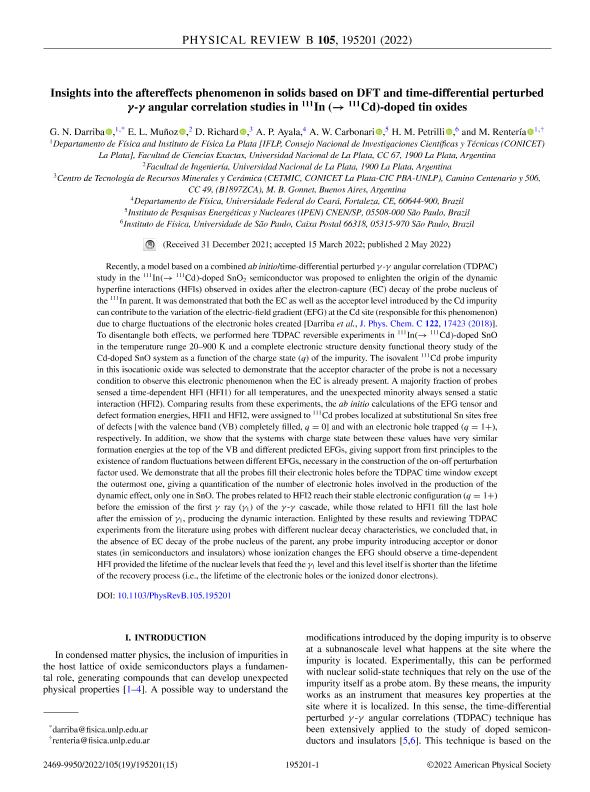Mostrar el registro sencillo del ítem
dc.contributor.author
Darriba, German Nicolas

dc.contributor.author
Muñoz, Emiliano Luis

dc.contributor.author
Richard, Diego

dc.contributor.author
Ayala, A. P.
dc.contributor.author
Carbonari, A. W.
dc.contributor.author
Petrilli, H. M.
dc.contributor.author
Rentería, Mario

dc.date.available
2023-07-24T12:59:50Z
dc.date.issued
2022-05
dc.identifier.citation
Darriba, German Nicolas; Muñoz, Emiliano Luis; Richard, Diego; Ayala, A. P.; Carbonari, A. W.; et al.; Insights into the aftereffects phenomenon in solids based on DFT and time-differential perturbed γ-γ Angular correlation studies in 111In (→ 111Cd) -doped tin oxides; American Physical Society; Physical Review B; 105; 19; 5-2022; 195201-195201
dc.identifier.issn
2469-9969
dc.identifier.uri
http://hdl.handle.net/11336/204967
dc.description.abstract
Recently, a model based on a combined ab initio/time-differential perturbed γ-γ angular correlation (TDPAC) study in the In111(→Cd111)-doped SnO2 semiconductor was proposed to enlighten the origin of the dynamic hyperfine interactions (HFIs) observed in oxides after the electron-capture (EC) decay of the probe nucleus of the In111 parent. It was demonstrated that both the EC as well as the acceptor level introduced by the Cd impurity can contribute to the variation of the electric-field gradient (EFG) at the Cd site (responsible for this phenomenon) due to charge fluctuations of the electronic holes created [Darriba, J. Phys. Chem. C 122, 17423 (2018)10.1021/acs.jpcc.8b03724]. To disentangle both effects, we performed here TDPAC reversible experiments in In111(→Cd111)-doped SnO in the temperature range 20-900 K and a complete electronic structure density functional theory study of the Cd-doped SnO system as a function of the charge state (q) of the impurity. The isovalent Cd111 probe impurity in this isocationic oxide was selected to demonstrate that the acceptor character of the probe is not a necessary condition to observe this electronic phenomenon when the EC is already present. A majority fraction of probes sensed a time-dependent HFI (HFI1) for all temperatures, and the unexpected minority always sensed a static interaction (HFI2). Comparing results from these experiments, the ab initio calculations of the EFG tensor and defect formation energies, HFI1 and HFI2, were assigned to Cd111 probes localized at substitutional Sn sites free of defects [with the valence band (VB) completely filled, q=0] and with an electronic hole trapped (q=1+), respectively. In addition, we show that the systems with charge state between these values have very similar formation energies at the top of the VB and different predicted EFGs, giving support from first principles to the existence of random fluctuations between different EFGs, necessary in the construction of the on-off perturbation factor used. We demonstrate that all the probes fill their electronic holes before the TDPAC time window except the outermost one, giving a quantification of the number of electronic holes involved in the production of the dynamic effect, only one in SnO. The probes related to HFI2 reach their stable electronic configuration (q=1+) before the emission of the first γ ray (γ1) of the γ-γ cascade, while those related to HFI1 fill the last hole after the emission of γ1, producing the dynamic interaction. Enlighted by these results and reviewing TDPAC experiments from the literature using probes with different nuclear decay characteristics, we concluded that, in the absence of EC decay of the probe nucleus of the parent, any probe impurity introducing acceptor or donor states (in semiconductors and insulators) whose ionization changes the EFG should observe a time-dependent HFI provided the lifetime of the nuclear levels that feed the γ1 level and this level itself is shorter than the lifetime of the recovery process (i.e., the lifetime of the electronic holes or the ionized donor electrons).
dc.format
application/pdf
dc.language.iso
eng
dc.publisher
American Physical Society

dc.rights
info:eu-repo/semantics/openAccess
dc.rights.uri
https://creativecommons.org/licenses/by-nc-sa/2.5/ar/
dc.subject
Aftereffects
dc.subject
TDPAC
dc.subject
DFT
dc.subject
Tin oxides
dc.subject
111In
dc.subject
111Cd
dc.subject
Dynamic hyperfine interaction
dc.subject
EFG
dc.subject
Impurities
dc.subject
Insulators
dc.subject
Semiconductors
dc.subject
Ab Initio
dc.subject
FP-APW+lo
dc.subject.classification
Física de los Materiales Condensados

dc.subject.classification
Ciencias Físicas

dc.subject.classification
CIENCIAS NATURALES Y EXACTAS

dc.title
Insights into the aftereffects phenomenon in solids based on DFT and time-differential perturbed γ-γ Angular correlation studies in 111In (→ 111Cd) -doped tin oxides
dc.type
info:eu-repo/semantics/article
dc.type
info:ar-repo/semantics/artículo
dc.type
info:eu-repo/semantics/publishedVersion
dc.date.updated
2023-07-07T18:02:18Z
dc.journal.volume
105
dc.journal.number
19
dc.journal.pagination
195201-195201
dc.journal.pais
Estados Unidos

dc.description.fil
Fil: Darriba, German Nicolas. Consejo Nacional de Investigaciones Científicas y Técnicas. Centro Científico Tecnológico Conicet - La Plata. Instituto de Física La Plata. Universidad Nacional de La Plata. Facultad de Ciencias Exactas. Instituto de Física La Plata; Argentina. Universidad Nacional de La Plata. Facultad de Ciencias Exactas. Departamento de Física; Argentina
dc.description.fil
Fil: Muñoz, Emiliano Luis. Universidad Nacional de La Plata. Facultad de Ingeniería; Argentina. Consejo Nacional de Investigaciones Científicas y Técnicas; Argentina
dc.description.fil
Fil: Richard, Diego. Provincia de Buenos Aires. Gobernación. Comisión de Investigaciones Científicas. Centro de Tecnología de Recursos Minerales y Cerámica. Consejo Nacional de Investigaciones Científicas y Técnicas. Centro Científico Tecnológico Conicet - La Plata. Centro de Tecnología de Recursos Minerales y Cerámica; Argentina
dc.description.fil
Fil: Ayala, A. P.. Universidade Estadual do Ceará; Brasil
dc.description.fil
Fil: Carbonari, A. W.. Comissao Nacional de Energia Nuclear. Centro de Lasers e Aplicacoes. Instituto de Pesquisas Energéticas e Nucleares; Brasil
dc.description.fil
Fil: Petrilli, H. M.. Universidade de Sao Paulo; Brasil
dc.description.fil
Fil: Rentería, Mario. Consejo Nacional de Investigaciones Científicas y Técnicas. Centro Científico Tecnológico Conicet - La Plata. Instituto de Física La Plata. Universidad Nacional de La Plata. Facultad de Ciencias Exactas. Instituto de Física La Plata; Argentina. Universidad Nacional de La Plata. Facultad de Ciencias Exactas. Departamento de Física; Argentina
dc.journal.title
Physical Review B
dc.relation.alternativeid
info:eu-repo/semantics/altIdentifier/url/https://journals.aps.org/prb/abstract/10.1103/PhysRevB.105.195201
dc.relation.alternativeid
info:eu-repo/semantics/altIdentifier/doi/http://dx.doi.org/10.1103/PhysRevB.105.195201
Archivos asociados
